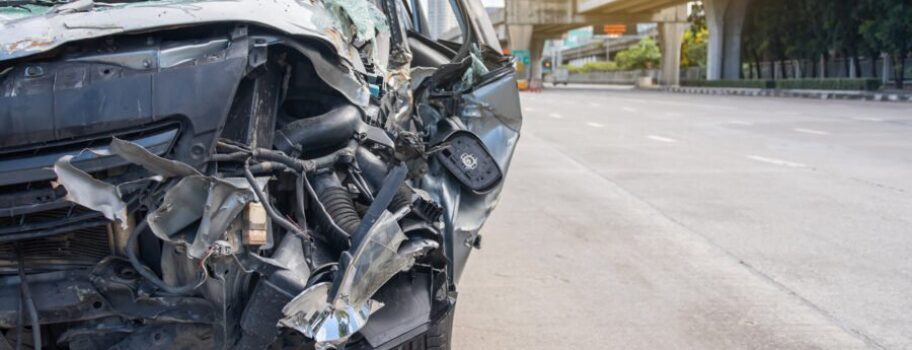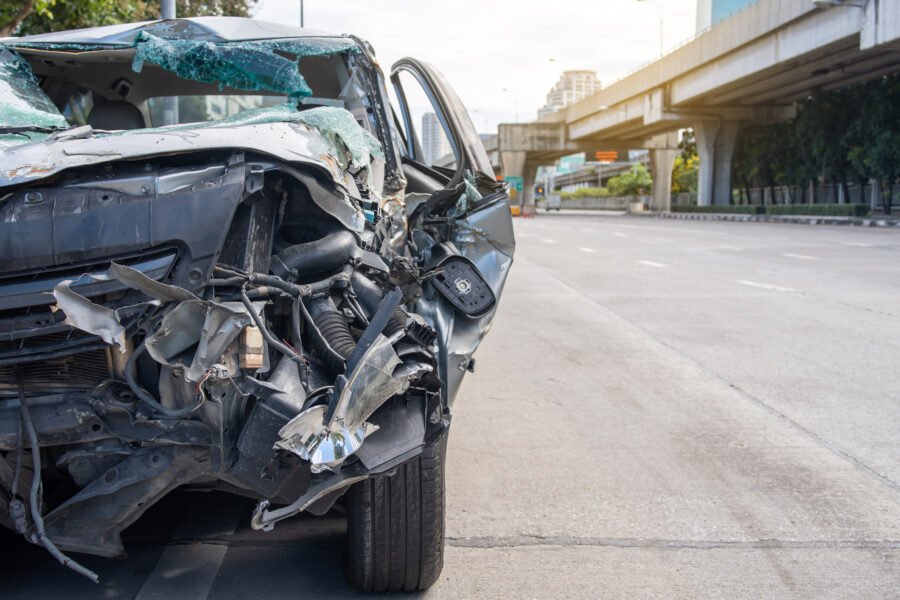Why Understanding the Cause of Your Crash Matters
Knowing what caused your accident does more than satisfy curiosity. It directly determines whether you can recover compensation for your injuries, medical bills, and damaged vehicle.
Texas law requires proving another driver’s negligence caused your crash before you can hold them financially responsible.
Accident causes often reveal negligence or reckless behavior that violates Texas traffic laws.
When a driver texts behind the wheel, speeds through construction zones, or drives drunk, they breach their legal duty to operate safely. This breach creates liability for damages they cause.
Many accident victims wrongly blame themselves when the other driver’s dangerous choices actually caused the collision.
If you’re unsure who was at fault, our legal team can help review your case for free.

10 Most Common Causes of Car Accidents in Texas
Texas roads see hundreds of thousands of crashes annually, but most stem from preventable driver behaviors. These leading causes, based on TxDOT crash data and decades of legal experience, show clear patterns of negligence.
Understanding these patterns helps victims recognize when they deserve compensation.
1. Distracted Driving
Distracted driving has become the modern epidemic on Texas roads.
It includes texting, adjusting navigation systems, eating, applying makeup, or any activity taking attention from driving.
TxDOT reports distracted driving contributes to 1 in 5 crashes statewide, causing thousands of preventable injuries annually.
Texas law specifically bans reading, writing, or sending text messages while driving. Cities like Dallas and Austin prohibit all handheld phone use.
Yet enforcement remains challenging because drivers delete texts or claim they were using GPS. This makes witness testimony and phone records crucial for proving distraction caused your crash.
The three-second rule illustrates distraction’s danger. At 55 mph, looking at your phone for three seconds means traveling the length of a football field essentially blindfolded.
When distracted drivers cause crashes, their insurance companies still try minimizing fault. Our attorneys have experience with texting and driving accidents and know how to prove distraction and maximize your recovery.
2. Speeding
Speeding remains a persistent killer on Texas highways. It reduces reaction time, increases stopping distance, and multiplies impact force exponentially.
Speed contributed to over 26,000 Texas crashes in 2024 alone. What might be a minor fender-bender at 30 mph becomes a catastrophic collision at 70 mph.
Texas posts speed limits based on ideal conditions. Drivers must reduce speed for rain, construction, heavy traffic, or poor visibility.
Failing to adjust speed for conditions constitutes negligence even when traveling under posted limits. Insurance companies often overlook this distinction when defending speeding drivers.
Proving speed requires more than just saying someone seemed fast. Skid mark analysis, damage patterns, and data from vehicle computers provide scientific evidence of pre-crash speeds.
Traffic camera footage and witness testimony support these technical proofs. When speed causes your injuries, you deserve compensation reflecting the conscious choice to endanger others.
3. Drunk Driving
Drunk driving represents perhaps the most preventable yet devastating cause of Texas crashes. Alcohol-related collisions killed over 1,200 Texans in 2024, destroying families who did nothing wrong except share the road.
These deaths and injuries result from selfish choices to drive impaired despite abundant alternatives.
Texas law creates enhanced liability for drunk drivers beyond typical negligence. Bars and restaurants face dram shop liability for overserving.
Drunk drivers may owe punitive damages and criminal charges don’t prevent civil recovery. These legal tools help victims recover full compensation while sending strong deterrence messages.
Drunk driving includes impairment from legal and illegal drugs, not just alcohol. Prescription medications, marijuana, and other substances impair judgment and reflexes.
Our drunk driving accident lawyers pursue every available remedy against impaired drivers and those who enabled them.
4. Running Red Lights and Stop Signs
Intersection violations create particularly dangerous crashes because they involve perpendicular impacts at full speed.
T-bone collisions from red light running often cause catastrophic injuries to drivers and passengers sitting mere inches from impact points. These crashes result from impatience, distraction, or deliberate risk-taking.
Proving red light violations requires quick evidence gathering.
Traffic camera footage gets deleted within days at many intersections. Witness memories fade. Skid marks wash away.
Insurance companies exploit these evidence gaps to dispute who had the green light, making immediate investigation crucial.
Texas law presumes drivers claiming green lights tell the truth absent contrary evidence. This makes independent witnesses and physical evidence essential for overcoming self-serving statements.
When someone’s reckless choice to run a red light changes your life, you deserve aggressive representation to prove what really happened.
5. Aggressive or Reckless Driving
Road rage and aggressive driving escalate minor traffic frustrations into dangerous confrontations.
Tailgating, cutting off other vehicles, brake-checking, and weaving through traffic at high speeds all constitute reckless driving. These behaviors show conscious disregard for others’ safety beyond mere negligence.
Texas Penal Code defines reckless driving as willful or wanton disregard for safety. This criminal violation creates strong civil liability.
Aggressive drivers often exhibit patterns including multiple moving violations, prior road rage incidents, or vehicular assault charges. This history strengthens punitive damage claims.
Dashcam footage has revolutionized proving aggressive driving. What once became “he said, she said” disputes now have video evidence.
Multiple witnesses often observe the same aggressive behaviors over extended distances. Our reckless driving accident attorneys use all available evidence to hold aggressive drivers accountable.
6. Fatigued Driving
Drowsy driving impairs judgment and reflexes similarly to alcohol intoxication. Studies show 24 hours without sleep equals 0.10 blood alcohol concentration in terms of impairment.
Yet fatigued driving receives less attention despite causing thousands of preventable crashes annually.
Commercial drivers, shift workers, and people with sleep disorders face highest risks. Federal hours-of-service rules limit trucker driving time precisely because fatigue kills.
When employers push drivers beyond safe limits or drivers ignore rest requirements, innocent motorists pay the price.
Proving fatigue requires investigating work schedules, logbooks, and witness observations of weaving or drifting. Drivers who fall asleep often leave no skid marks because they never brake.
Single-vehicle crashes into barriers or off-road excursions suggest fatigue. These cases demand thorough investigation to prove what common sense already knows about exhausted driving.
7. Unsafe Lane Changes or Merging
Improper lane changes cause sideswipes, forced road departures, and multi-vehicle pileups. Drivers who change lanes without signaling, checking blind spots, or yielding to existing traffic create unnecessary dangers.
These crashes often involve disputed fault requiring careful investigation.
Texas Transportation Code requires signaling lane changes and only moving when safe. “Safe” means more than just having physical space.
It requires considering other vehicles’ speed and proximity. Cutting off approaching traffic violates this duty even if technical clearance exists momentarily.
Multiple factors often combine in lane-change crashes. A distracted driver might attempt an unsafe lane change while speeding. Construction zones compress traffic, reducing margin for error.
Bad weather decreases visibility. Understanding all contributing factors helps establish primary fault and maximize recovery.
8. Poor Weather or Road Conditions
Texas weather creates diverse driving challenges from ice storms to flooding to dust storms. While nobody controls weather, drivers must control their response to conditions.
Texas law requires reducing speed and increasing caution when weather compromises safety. Failing to adjust driving for conditions constitutes negligence.
Government entities maintaining roads may share liability for dangerous conditions. Missing warning signs, inadequate drainage causing hydroplaning, or untreated ice accumulation can create municipal liability.
These claims face special notice requirements and sovereign immunity challenges requiring experienced counsel.
Weather doesn’t excuse crashes but rather increases driver responsibility. Insurance companies arguing “act of God” defenses ignore that reasonable drivers avoid most weather-related crashes through appropriate caution.
When someone’s failure to respect dangerous conditions injures you, weather explains but doesn’t excuse their negligence.
9. Vehicle Defects or Malfunctions
Mechanical failures like brake failure, tire blowouts, or steering loss cause terrifying loss of control.
While some failures result from poor maintenance creating owner liability, others stem from manufacturing or design defects triggering product liability claims against vehicle or part manufacturers.
Preserving physical evidence becomes crucial in defect cases. Vehicles get repaired or scrapped quickly, destroying proof. Failed parts need expert examination before disposal.
Electronic data from vehicle computers requires immediate downloading. Product liability cases demand different expertise than standard negligence claims.
Recent recalls affecting millions of vehicles show defect risks remain real. Takata airbags, ignition switches, and unintended acceleration made headlines, but thousands of lesser-known defects exist.
When mechanical failure causes your crash, determining whether negligent maintenance or product defects bear responsibility affects both liable parties and potential recovery.
10. Inexperienced or Unlicensed Drivers
Young drivers, elderly drivers with diminished abilities, and unlicensed drivers pose elevated risks. Texas’s graduated license system recognizes teenage inexperience, but violations remain common.
Unlicensed drivers often lack insurance, complicating recovery despite their obvious negligence in driving illegally.
Inexperience shows through panic reactions, overcorrecting, or freezing during emergencies. These drivers might technically follow rules while lacking judgment for complex situations.
Their parents may face liability for negligent entrustment when allowing unsafe driving.
Unlicensed drivers present special challenges because they often lack assets or insurance. Uninsured motorist coverage becomes crucial. Immigration status doesn’t affect injury rights, though some victims fear pursuing claims.
Everyone injured by negligent driving deserves compensation regardless of the at-fault driver’s license status.
What If Multiple Factors Caused the Crash?
Real-world crashes rarely have single causes. A drunk driver might also speed through a red light during rain. A texting driver might make an unsafe lane change into a vehicle with worn brakes.
Multiple causation factors don’t eliminate liability but require careful analysis of how fault should be allocated.
Texas’s Comparative Negligence Law
Texas follows modified comparative negligence rules allowing recovery when you’re 50% or less at fault. Your settlement reduces by your fault percentage.
If you’re 20% responsible for a $100,000 claim, you recover $80,000. But crossing 51% fault eliminates all recovery regardless of injuries.
This system recognizes accident complexity while preventing mostly-responsible parties from shifting costs. Insurance companies aggressively push fault onto victims, knowing that inflating your percentage from 45% to 55% saves them everything.
Fighting these tactics requires understanding both legal standards and practical negotiation strategies.
Examples illustrate how multiple causation works. You’re speeding slightly when a drunk driver runs a red light, hitting you.
The drunk driver bears 90% fault for the severe violation, while your minor speeding contributes 10%. You’d recover 90% of damages. Understanding Texas comparative negligence laws helps protect your rights when fault is disputed.
Proving the Cause of a Car Accident in Texas
Identifying an accident’s cause is only the first step. Proving causation legally requires evidence meeting courtroom standards.
Insurance companies dispute obvious causation hoping victims lack proof. Building strong cases demands immediate action and strategic evidence gathering.
Key Evidence to Gather
Physical evidence from crash scenes vanishes quickly. Photograph vehicle damage from multiple angles, showing impact points and force direction.
Document road conditions, weather, visibility, and traffic control devices. Capture skid marks, debris patterns, and final vehicle positions before towing changes everything.
Witness information becomes harder to obtain over time. Get names and phone numbers immediately. Record brief statements while memories remain fresh.
Independent witnesses without personal stakes provide crucial credibility. Business employees or uninvolved drivers offer better testimony than passengers.
Official documentation creates foundational evidence.
Police reports establish initial fault determinations and document violations. Medical records link injuries to crash forces. Repair estimates prove property damage extent. Time stamps on photos and reports prevent later disputes about conditions or timing.
How a Lawyer Can Strengthen Your Case
Strategic advocacy maximizes case value.
Experienced attorneys know which causes support higher damages and how to prove them. They counter insurance company tactics designed to shift blame.
Most importantly, they prepare cases for trial, motivating fair settlements. Our car accident attorneys use every available tool to prove causation and maximize recovery.
FAQs About Car Accident Causes and Fault
How do I know if the accident wasn’t my fault?
Even if you made minor mistakes, the other driver may hold primary responsibility under Texas law. Fault depends on whose actions primarily caused the crash, not who was perfect.
If you were obeying traffic laws when someone else’s dangerous behavior caused impact, you likely have a valid claim.
Minor infractions like slightly exceeding the speed limit don’t excuse drunk driving, running red lights, or texting while driving. An experienced attorney can evaluate comparative fault and determine if you have a case.
Does the cause of the accident affect how much I can recover?
Yes, the cause significantly impacts potential compensation. Intentional or reckless behaviors like drunk driving or road rage support punitive damages beyond basic compensation.
Clear violations make liability easier to prove, strengthening your negotiating position. Some causes involve multiple liable parties.
Commercial vehicle crashes might include driver and employer liability. Mechanical failures could involve manufacturers.
More serious causes typically result in higher settlements reflecting increased culpability.
Can I still recover if I was partially at fault?
Texas law allows recovery as long as you weren’t more than 50% responsible. Your compensation reduces by your fault percentage, but partial fault doesn’t eliminate claims.
Insurance companies exaggerate minor mistakes trying to push victims over 51% fault. Common tactics include claiming you could have avoided the crash with perfect reactions or that minor violations contributed equally to major ones.
Legal representation protects against these inflated fault assignments.
Is it worth hiring a lawyer if I know the cause of the accident?
Knowing the cause is only the beginning. Proving it legally while maximizing compensation requires experience insurance companies respect.
Attorneys identify all liable parties, preserve crucial evidence, and counter tactics designed to minimize payouts. They handle complex negotiations while you focus on recovery.
Most importantly, they prepare cases for trial if needed, motivating fair settlements. Free consultations let you understand your options without obligation.
You Deserve Answers and Legal Help That Understands Your Story
Every crash has a cause, and most involve someone’s preventable choice to drive dangerously.
Whether distraction, intoxication, or simple carelessness caused your injuries, you deserve more than insurance company excuses. Texas law provides rights to compensation when others’ negligence harms you.
Angel Reyes & Associates has handled thousands of Texas accident cases across all causes.
We uncover what really happened when insurance companies try hiding the truth. Our investigation reveals evidence others miss. Most importantly, we fight for every dollar you deserve, not quick settlements that shortchange your future.
Contact us now to start getting answers and building your path to recovery.













